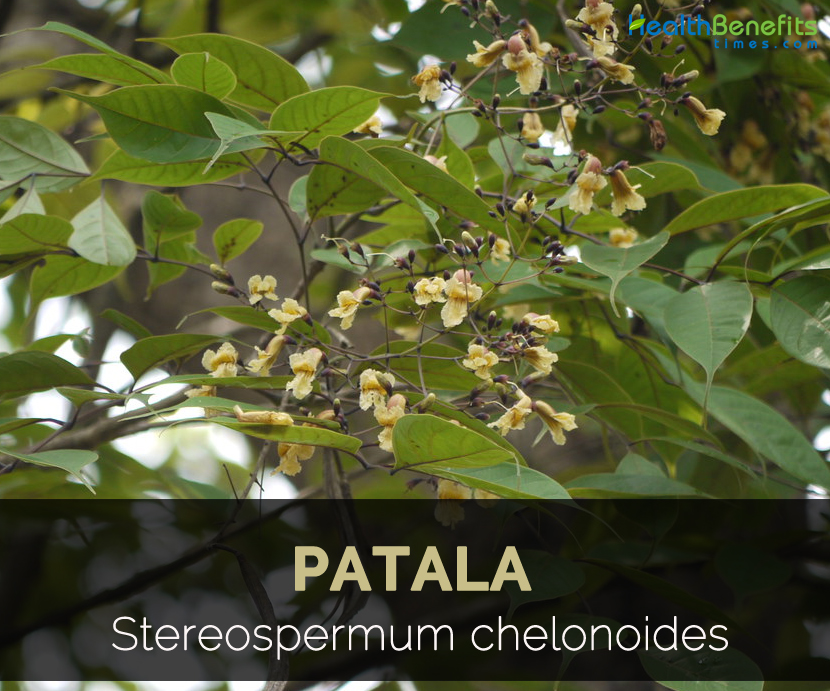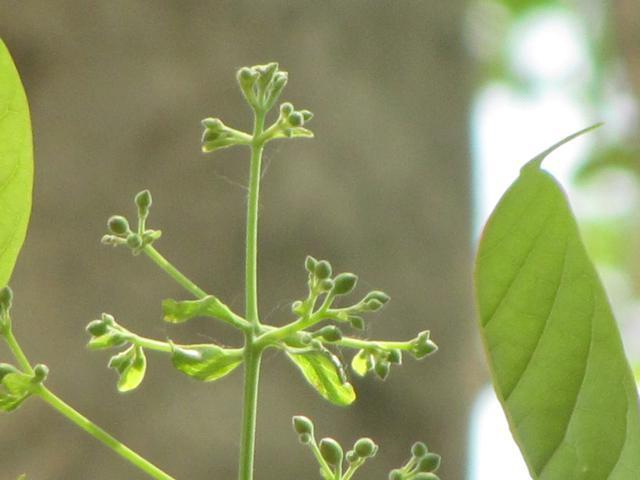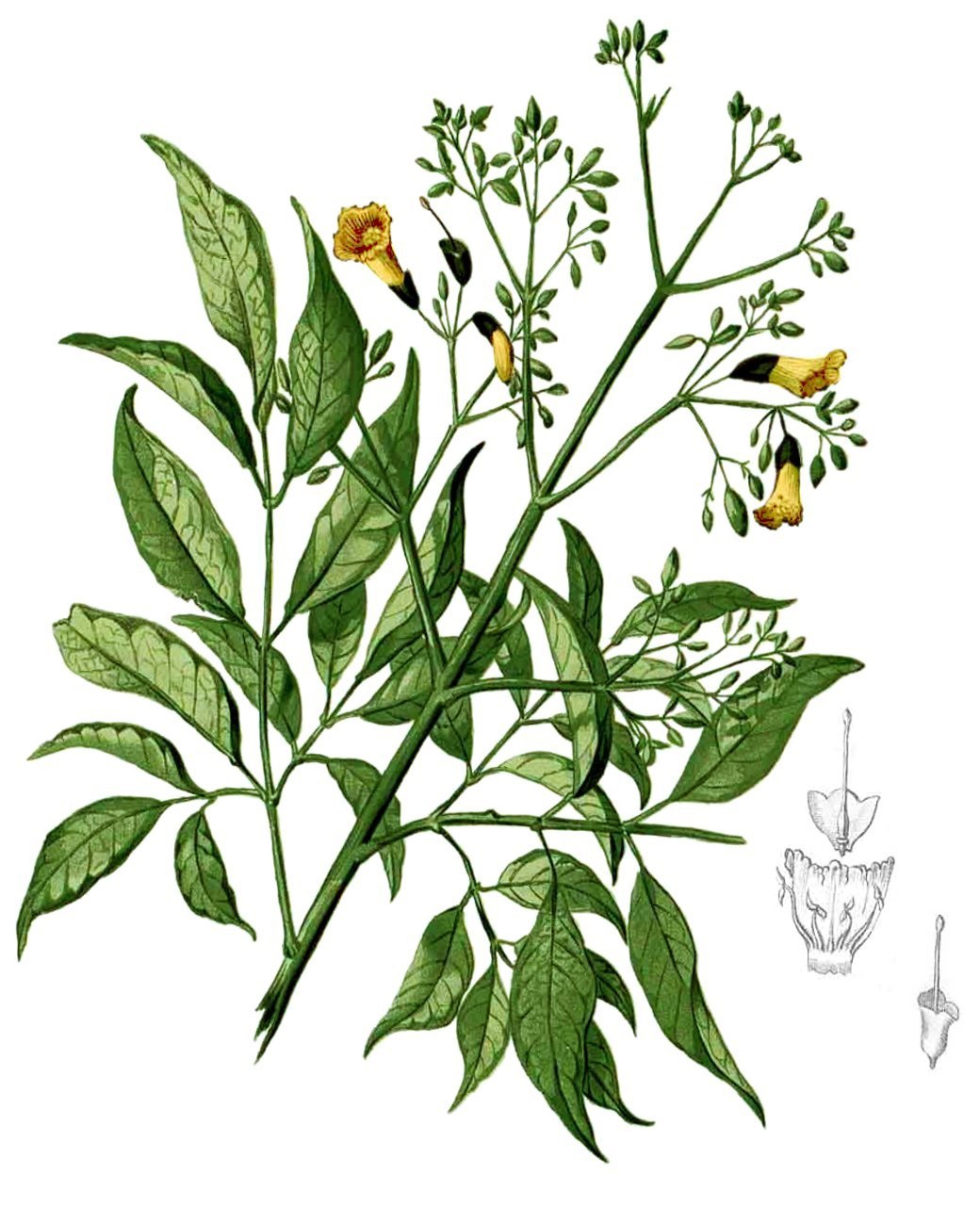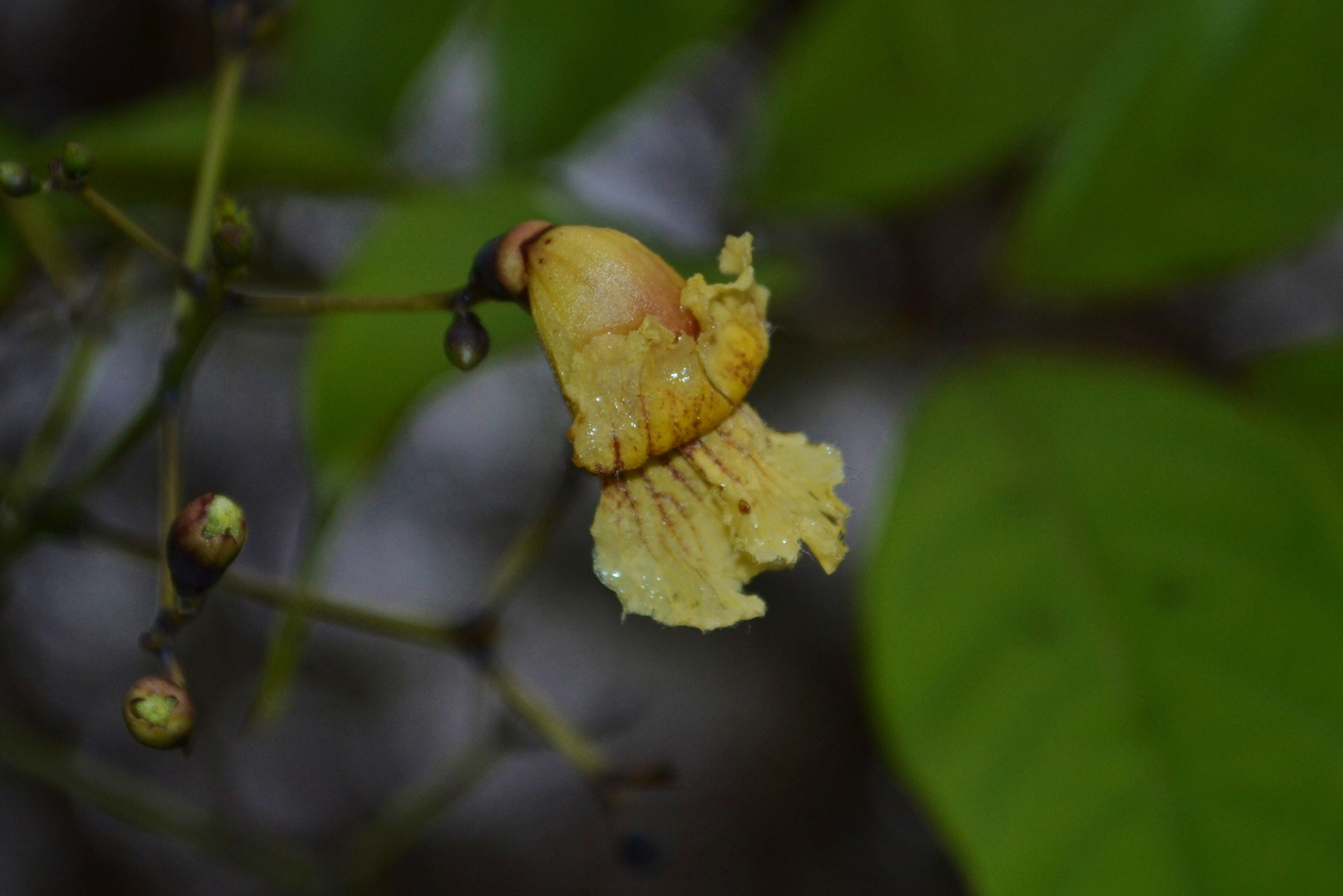Wood is used for construction work, beam, planks, carriage, carts, furniture, wagons, tool handles and cabinet work. In Theravada Buddhism, the plant is used as tree for achieved enlightenment, or Bodhi by third Lord Buddha known as Saranankaraand twenty second Lord Buddha.
Plant description
The tree measures 9 to 18 meters high with grey or dark brown bark. Leaves are pinnate with 30 to 60 cm long with 3 to 4 pairs of leaflets. Terminal one is 7.5-15 cm long and 5 to 7.5 cm wide and is broadly elliptic. There are 6-8 pairs of main nerves and petioles of lateral leaflets are less than 2.5 mm long. Flowers have sweet fragrance borne in large, lax trichotomous which is viscidly hairy panicles. A calyx is 1 cm long and is shaped like a bell or campana. It is hairy with 3-5 lobes which are broad and short. Corolla is tubular and campanulate with purple and dull crimson. Fruit is a capsule which is cylindrical, usually straight and slightly ribbed. It is rough with elevated whitish specks or valves are hard and thick. Flowers are used to treat burning sensations and bilious diarrhoea.
Health Benefits of Stereospermum chelonoides
- Cardiovascular health
The herb acts as a cardiac tonic which helps to maintain healthy heart as it strengthens heart muscles and arteries. It helps to maintain proper flow of blood in the body. It is used for treating anorexia and improves the appetite.
- Piles
It is effective in treating piles. It promotes digestive health and resolve constipation. It is used for problems such as irritation, itching, soreness, redness and swelling around anus.
- Lower inflammation
It helps to lower edema and helps inflammatory conditions and also lowers pain.
- Blood purifier
It eliminates toxins from blood and also purifies it. It is helpful for difficult breathing, hiccups, vomiting and thirst.
- Blood disorders
The herb is used for blood disorders such as anemia. It promotes production of red blood cells. It also provides relief from symptoms associated with anemia such as lethargy, fatigue and weakness.
Traditional uses
- Roots are used for treating diseases such as bronchial asthma, blood disorders, jaundice, vomiting, paralysis, rheumatism.
- For rheumatoids, use the decoction made from roots.
- Mix the ash of burned roots and barks with water and use for treating blockage of urinary tract.
- Mix the flowers with honey and use it orally for hiccups.
- In Southern India, bark is traditionally used as diabetes treatment.
- Fruits are used for leprosy.
- Bark, roots, flowers and leaves are used for eructation, piles, malaria, piles, diarrhea and loss of taste.
- Flowers are used for bleeding.
- It balances three doshas and manages anorexia, bronchitis, asthma ad bronchitis, edema, inflammation, hiccups, edema, excessive thirst and blood disorders.
- It is a diuretic which helps to ease urination and maintains proper urine flow. It provides relief from difficulty in urination, burning sensation and frequent urination.
- It is helpful in gastric ulcers and gastritis.
- The decoction of bark is used for ulceration and acidity.
- It is used to cure digestive disorders and used for anorexia, diarrhea and piles.
References:
https://pdfs.semanticscholar.org/7fd5/b2fc435e4983be3954e6cd6fb6de1ee423bd.pdf
https://en.wikipedia.org/wiki/Stereospermum_chelonoides
https://www.flowersofindia.net/catalog/slides/Fragrant%20Padri%20Tree.html
https://www.asia-medicinalplants.info/stereospermum-chelonoides-l-f-dc/
https://ayurwiki.org/Ayurwiki/Stereospermum_chelonoides_-_Patala
https://vasanai.wordpress.com/2016/03/26/stereospermum-chelonoides-uses/
https://www.indianetzone.com/38/patala_plants.htm
https://www.planetayurveda.com/library/patala-stereospermum-suaveolens/
http://allayush.com/2017/04/29/medicinal-uses-health-benefits-stereospermum-suaveolens-patala/
Comments
| Patala Quick Facts | |
|---|---|
| Name: | Patala |
| Scientific Name: | Stereospermum chelonoides |
| Origin | South Asia |
| Shapes | Capsule , loculicidal or septicidal, 30-60 x 0.5 cm |
| Name | Patala |
|---|---|
| Scientific Name | Stereospermum chelonoides |
| Native | South Asia |
| Common/English Name | Hindi: paral/ padaria; Bengali: parlu; Marathi: padal; Assamese: paroli, parhori, ser phang; Garo: bolsel; Kannada: adri, bili paadri, giri, hadari; Khasi: dieng sir Malayalam: karannavu, kacasthali, karanyavu; Marathi: kalgari, kalagori, paadal; Mizo: zinghal; Naga: Ing-nge-ching; Nepali: jinghal, Kuber bacha, parhori; Sanskrit: patala, kastapatala; Tamil: ambuvagina, pathiriver, padiri, pumbadiri; Telugu: ambuvaasini, goddalipukusu, gallugudu, isakarasi |
| Plant Growth Habit | Trees, or shrubs, or lianas |
| Plant Size | 15 – 30 meters tall |
| Root | Taproot |
| Bark | Grey or dark brown |
| Leaves | 30-45 cm long, imparipinnate, opposite |
| Leaflets | 7-15 cm long, long-pointed, broadly elliptic |
| Flower | Pink, bisexual, 18 mm long |
| Fruit shape & size | Capsule , loculicidal or septicidal, 30-60 x 0.5 cm |
| Seed pod | 1-2 ft long, long, cylindrical, ribbed |





